
| What is Flavor and Fortune? |
| How do I subscribe? |
| How do I get past issues? |
| How do I advertise? |
| How do I contact the editor? |
Read 13093556 times
Connect me to:
| Home |
| Articles |
| Book reviews |
| Letters to the Editor |
| Newmans News and Notes |
| Recipes |
| Restaurant reviews |
| Article Index (all years, slow) |
| List of Article Years |
| Article Index (2025) |
| Article Index (last 2 years) |
| Things others say |
| Related Links |
| Log In... |
| Authors |
| Categories & Topics |
Weddings are Wonderful
| by Jacqueline M. Newman |
Holidays and Celebrations
Fall Volume: 2010 Issue: 17(3) page(s): 15, 16, 17, and 18
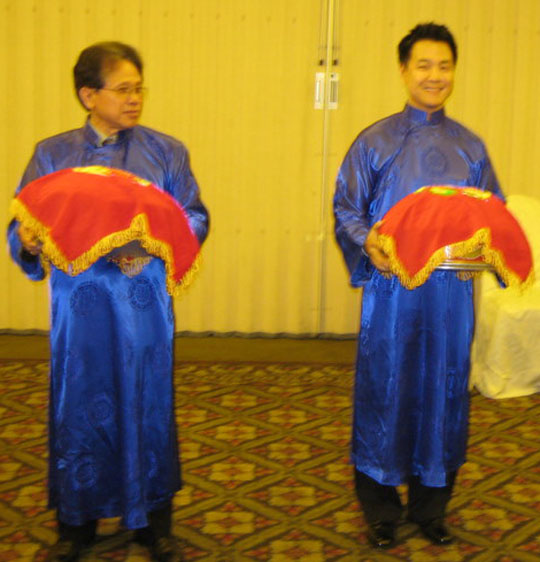 Chinese weddings are loaded with things symbolic, things ancient, even a few touches of modernity. Included among them is much to eat, many to greet, and views of what parents want to see in their future. Some require lots of planning, others oodles of pre-preparation, and there are the last minute things to do. This article explores many details of weddings for Han majority peoples in China and abroad. It takes peeks at a few things government and family consider important. It does not look at any of the fifty-five ethnic minority groups, all of whom have special wedding protocols. Some of these will be discussed in future articles.
Chinese weddings are loaded with things symbolic, things ancient, even a few touches of modernity. Included among them is much to eat, many to greet, and views of what parents want to see in their future. Some require lots of planning, others oodles of pre-preparation, and there are the last minute things to do. This article explores many details of weddings for Han majority peoples in China and abroad. It takes peeks at a few things government and family consider important. It does not look at any of the fifty-five ethnic minority groups, all of whom have special wedding protocols. Some of these will be discussed in future articles.
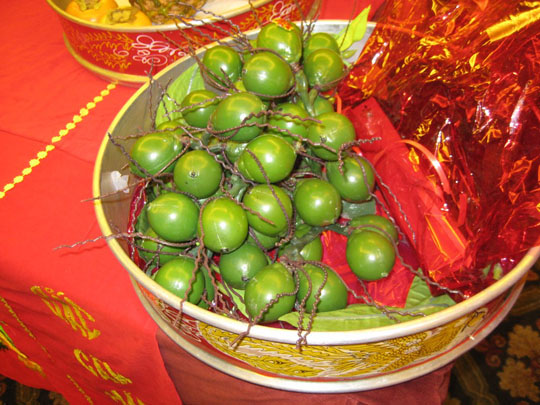 Six wedding rites were symbolic and important until the end of the last dynasty. These were na cai or acceptance of a present given to the girl's family showing they would consider the proposal. Historically, this gift was often a goose. Then came the wen ming or asking the name when horoscopes were compared, often done through a go-between so if they were not acceptable, there was no loss of face. Then came the na ji or acceptance which folks today would call a betrothal; this was both sets of parents agreeing their son and daughter would wed. This could be done any time from birth onward. The fourth item, the na cheng was time to exchange gifts, most of food, and most often these were cakes or biscuits, colored or not, big and wedding cake-like or small and more like biscuits. This was followed by a fifth rite called qing qi or asking the date, even settling on a place. This required dealing with a feng shui master and others to assure the selected place, day, date, and time were propitious. Lastly was the ying qing or receiving the bride. That was just before the ceremony, a time in days or hours, when the girl moved to her new home and left her parents home forever.
Six wedding rites were symbolic and important until the end of the last dynasty. These were na cai or acceptance of a present given to the girl's family showing they would consider the proposal. Historically, this gift was often a goose. Then came the wen ming or asking the name when horoscopes were compared, often done through a go-between so if they were not acceptable, there was no loss of face. Then came the na ji or acceptance which folks today would call a betrothal; this was both sets of parents agreeing their son and daughter would wed. This could be done any time from birth onward. The fourth item, the na cheng was time to exchange gifts, most of food, and most often these were cakes or biscuits, colored or not, big and wedding cake-like or small and more like biscuits. This was followed by a fifth rite called qing qi or asking the date, even settling on a place. This required dealing with a feng shui master and others to assure the selected place, day, date, and time were propitious. Lastly was the ying qing or receiving the bride. That was just before the ceremony, a time in days or hours, when the girl moved to her new home and left her parents home forever.
MOTHER OF THE BRIDE, years before, begins thinking of all she would have to do for the wedding of her daughter. Some began these thoughts from the day of her birth. The father might think of the economics of the wedding and he might set about burying some wine to use near the day of her wedding and at the wedding itself. He usually uncovered these jugs of wine days or hours before his daughter's soon-to-be in-laws come to visit and talk terms for the first and often the only time before the wedding day. Sometimes he uses some of this cache for the wedding meal, sometimes not.
Many mothers of daughters begin making things for the wedding and for her daughter's new home as soon as she can. She needs to prepare household things for where her daughter will eventually move to, often far from the home of her birth. Not doing so sends signals that the bride comes from poor people and she, her husband, and her daughter can lose face.
History tells, in Chinese texts from at least 400 BCE, that there are complex rituals considered necessary to ensure a successful marriage. The mother of the bride needs to send her daughter off appropriately so she makes things for her and her future home. The groom's parents, once the bride is selected, take charge and develop strategies needed to continue their successful ancestral line.
AFTER THE MARRIAGE, most girls move into the home of her in-laws where her job will be to please them, serve them tea on the wedding day, and serve them just about every thing in the days thereafter. She belongs to them and to her husband, whom she also serves, but not until she meets the needs of her new mother-in-law.
Therefore after a daughter is born, her mother sometimes with the help of other female household members, begins setting aside silks for her wedding dress, other fabrics for clothes in her future life, and still others needed to use on her bed, in her bath, and elsewhere. With or without help, she makes clothes to use in her daughter's wedded life and she makes bedding, tablecloths, and other household items for her daughter's marital life.
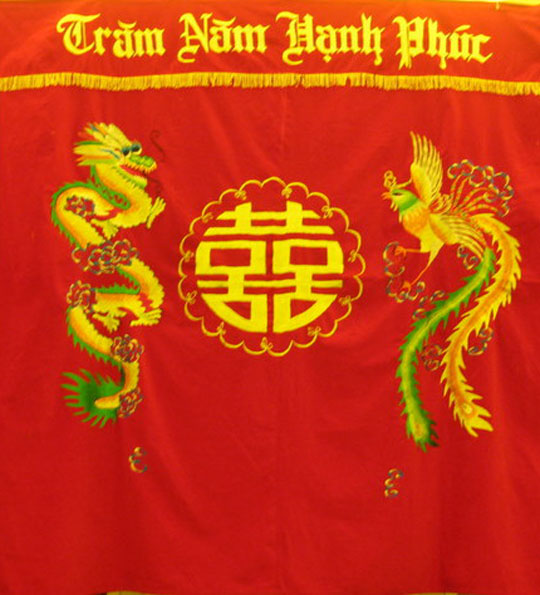 SYMBOLIC ITEMS later baked, and sometime bought or sent for include household linens and common items of bedding, bath, and beauty. Many will be decorated with lotus blossoms and flowers symbolic of fertility. Others will have chestnut designs for easy in birthing future grandsons. Still others will include peach blossoms to wish the bride and her future husband a long life. There will be red-colored items wishing much happiness, duck and goose eggs embroidered on things as wishes for many offspring, etc.
SYMBOLIC ITEMS later baked, and sometime bought or sent for include household linens and common items of bedding, bath, and beauty. Many will be decorated with lotus blossoms and flowers symbolic of fertility. Others will have chestnut designs for easy in birthing future grandsons. Still others will include peach blossoms to wish the bride and her future husband a long life. There will be red-colored items wishing much happiness, duck and goose eggs embroidered on things as wishes for many offspring, etc.
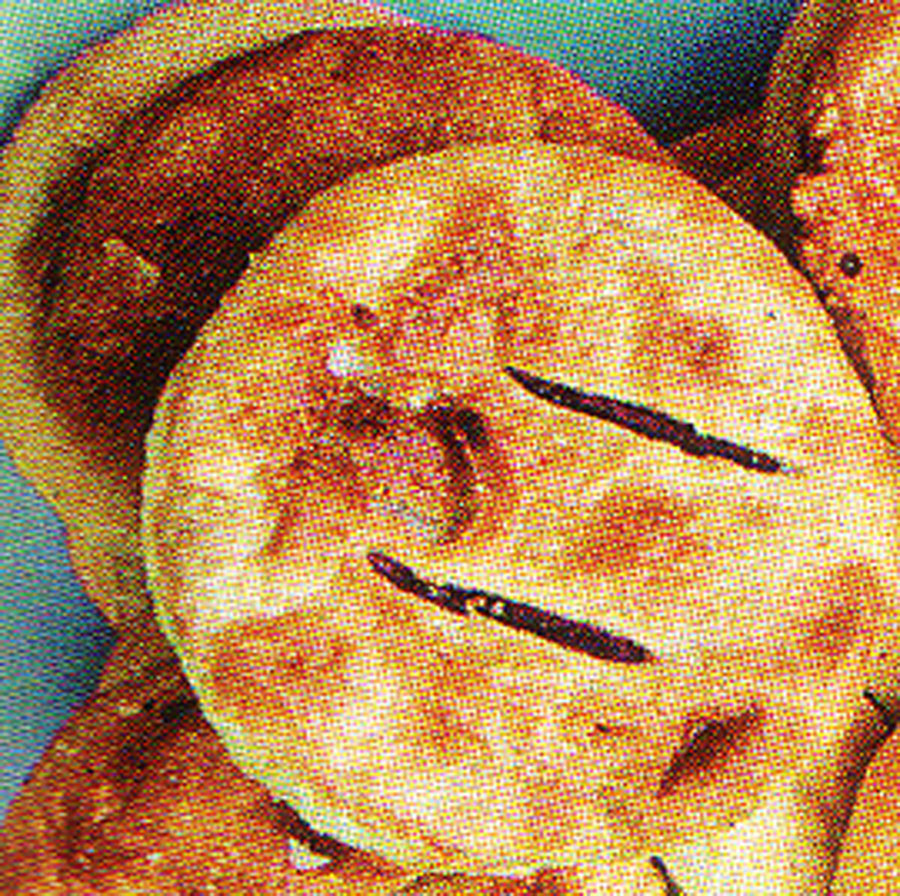 NEAR THE WEDDING DAY, she or her husband, and the parents of the groom-to-be or both will consult a feng shui master or geomancy maven to set the date and the location for the marriage. Close to the actual nuptials, the mother will bake 'wife cakes' to symbolize the love and romance she hopes they will have, and she will prepare other symbolic foods. Why wife cakes? They represent a loyal wife who, it is said, sold herself into slavery to buy a cure for an in-law parent. Her husband then bakes many lao po bing, also known as 'wife cakes,' to raise enough money to buy her back. If you want to impress soon-to-be in-laws, a recipe for them follows at the end of this article.
NEAR THE WEDDING DAY, she or her husband, and the parents of the groom-to-be or both will consult a feng shui master or geomancy maven to set the date and the location for the marriage. Close to the actual nuptials, the mother will bake 'wife cakes' to symbolize the love and romance she hopes they will have, and she will prepare other symbolic foods. Why wife cakes? They represent a loyal wife who, it is said, sold herself into slavery to buy a cure for an in-law parent. Her husband then bakes many lao po bing, also known as 'wife cakes,' to raise enough money to buy her back. If you want to impress soon-to-be in-laws, a recipe for them follows at the end of this article.
Another common story about wife-cakes is about a poor young couple. The woman in that union bakes round candied winter-melon filled wife-cakes so her husband can share them with his family to show respect. We have yet to locate a recipe for these wife cakes.
YEAR'S PAST, a bridal gown was woven of the best silk a family could afford, woven and then made by the bride's mother. It showed the status of her family. Just before the wedding, it was made into a long dress with high slits on its sides, one called a qi pau. She also made a jacket or tunic called a da gua to go with it. The fabric often had a symbol for double happiness called er xi woven into it, or a dragon and a phoenix as does the red cloth seen here used on the ancestral table. This is to symbolize the groom's power and the bride's life-giving abilities; they emulate bride and groom being emperor and empress on their wedding day.
ENGAGEMENTS were popular in the past, some of them happening at birth, a female child pledged to a male in another family. Now outlawed, this was not without potential problems. What if that male child dies? Then that girl grew up a widow. Alternately, if she dies, he can remarry.
Should the to-be engaged both live, there are gifts the parents of the groom-to-be needs give to the bride-to-be's family. It might be a roast pig with or without one or more large bags of rice, special cakes, and other food items. There were called 'call cakes.' Sometimes they gave four-colored biscuits which were then used by the girl's family to announce the upcoming wedding.
GROOMS used to pay a 'bride’s price' in return for the dowry her mother had been making and/or purchasing and setting aside. Now, the government has outlawed these practices, particularly the dowry. But in truth, the practice continues often in lower or greater amounts. Sometimes the dowry was or is given months or years later. Part of it can be wedding cakes heavy with dried fruits and nuts, a cock, a hen, or both, even a goose and a gander. Other gifts exchanged include wheat-flour dolls.
The groom's family also sends or bring noodles, peanut cakes, sweet bean biscuits, and other grain foods. They package them in red or red and blue ribbon, and almost always give them in groups of five. Some of the food items can be topped with caramelized sugar, others made sweet with sugary fruits, sweetened nuts, and/or sweetened seeds. Many are put into five-sided boxes, which the Chinese consider lucky. They also give or bring golden baked items that look like rolls of money. These gifts can be given at the engagement, if there is one, if not they often arrive some time before the actual wedding.
AT THE WEDDING CEREMONY, there can be, but is not necessary to have, flowers. If they do use them, they symbolize life, happiness, even fertility. Often they are red, never white because that color symbolizes death. Many weddings decorate with four kinds of flowers to symbolize the four virtues of Buddhism. These are peonies to symbolize renewed life, daffodils to represent change, orchids as symbols of love and fertility, and lotus blossoms as they symbolize the Buddhist religion.
Brides wanting flowers need to think spring as they are more available then. Late February is another popular time for weddings because peach blossoms are popular and often available then; they are symbolic of long life.
A wedding can have a pair of lanterns symbolic of double happiness or it can serve two ducks or two geese. The lanterns can be in the nuptial room the first night the couple spends together. On the day of or the day before the actual wedding, and in some regions on the day after the wedding, bride and groom pay homage to their ancestors as was done at a recent wedding (see the picture on this page). At some weddings, this is done after the couple takes their wedding vows. Whenever, they kneel together bowing three times to symbolize their coming together as one. Parents of both can do likewise to show the two families will be one.
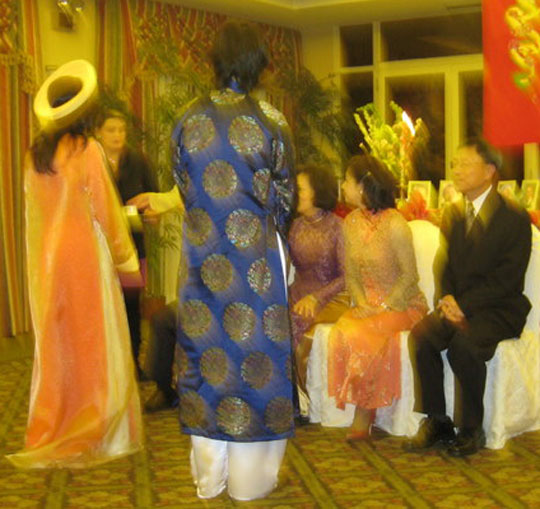 SERVING TEA by bride and groom at weddings or just before or just after them can be to each other, to the bride's in-laws, and to their parents, usually it is in this order but after they pay respects to their ancestors. In years past, the bride went to the room where they would spend their first night, stayed on the kang or bed; and there she was teased by his and her many friends; she never got off the kang, did not go to the reception/dinner to honor the marriage, not even to the bathroom; to do so was bad luck. When the groom came in to stay or just say hello, he took off her veil and got to see her for the first time. Why had he not seen her before? To do so was not thought important; all arrangements had been made by both sets of parents with or without a matchmaker; they were the important parties to this marriage.
SERVING TEA by bride and groom at weddings or just before or just after them can be to each other, to the bride's in-laws, and to their parents, usually it is in this order but after they pay respects to their ancestors. In years past, the bride went to the room where they would spend their first night, stayed on the kang or bed; and there she was teased by his and her many friends; she never got off the kang, did not go to the reception/dinner to honor the marriage, not even to the bathroom; to do so was bad luck. When the groom came in to stay or just say hello, he took off her veil and got to see her for the first time. Why had he not seen her before? To do so was not thought important; all arrangements had been made by both sets of parents with or without a matchmaker; they were the important parties to this marriage.
Planning for and paying for the wedding dinner was usually the responsibility of the groom's parents. At this meal, the finest food they could afford was served, and served as elegantly as possible. The parents of the groom also arranged for and paid for entertainment be they musicians and/or acrobats, both commonly used.
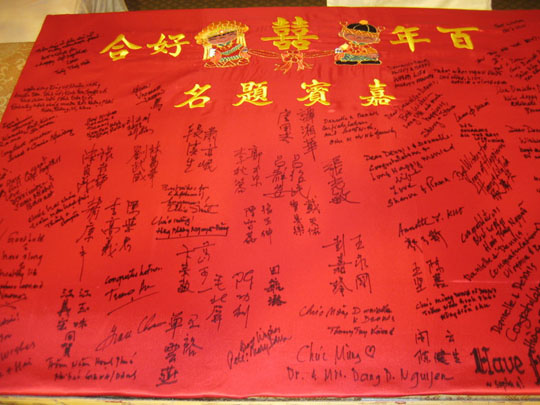 GUESTS HAVE RESPONSIBILITIES too, beside giving red envelopes whose money was sometimes used to pay for the food. Some gave and still give household items. Guests also have to sign a large red cloth before leaving; it is used as the first night's sheet. At some weddings it is signed on the way in, at others on the way out. If the latter, next to it sits a brother or brother-in-law putting all red envelopes in a red-covered box and recording who enclosed how much in each of them.
GUESTS HAVE RESPONSIBILITIES too, beside giving red envelopes whose money was sometimes used to pay for the food. Some gave and still give household items. Guests also have to sign a large red cloth before leaving; it is used as the first night's sheet. At some weddings it is signed on the way in, at others on the way out. If the latter, next to it sits a brother or brother-in-law putting all red envelopes in a red-covered box and recording who enclosed how much in each of them.
CURRENT WEDDINGS still reflect ancient roots. Circa 400 BCE and until today, many are still practiced. Now, rare is there a go-between who helps a bride's family and helps that of the groom to select the appropriate bride. Also rare is a wedding where bride and groom never see each other before the actual wedding ceremony. In addition, rare is a common gift a mother gave her daughter, her own chamber pot. Rare, too,nowadys is the bride not attending her own wedding dinner.
Games at weddings are other passé items. In years gone by, these games were played on the couple by their friends. Some were vicious, others funny, and all designed to embarrass either bride, groom, or both. Also rare is the bride who does not eat or drink for several days before the wedding so that she will not need to relieve herself using the groom's family facilities. I was recently also told that giving a goose is no longer a common practice because that animal symbolizes the only wife this groom will ever have.
Bridal chairs are also an item of the past at most weddings. They were used when groom's men came to the bride's house to carry her in this sedan chair to the groom's home. Nowadays, rarely does the couple kneel before the kitchen god, known as Tsao Chun, in either home. In one it was to say she will no longer live here, in the other it was to advise him this is her new home. Also, bride and groom no longer receive guests and serve them tea in the bridal chamber after the wedding. But there is something they do in this age of conspicuous consumption, they or someone they or their parents appoint, unwrap all gifts and puts them in a room with a sign on each item, telling who gave which gift; this is for all to see.
The marital bed, on the next morning used to be inspected by the groom's parents. They came in or it was handed out so they could examine the signed red sheet to see if the wedding was physically consumated, that the bride was a virgin, etc. This no longer happens in cities, but sometimes it does in the countryside.
A RECENT WEDDING of a young Chinese man and his Vietnamese bride, there were interminglings of both cultures. This is more and more common at weddings these days. At this delightful event at a large hotel, festivities began with a bi-cultural tea ceremony, the groom and his party wearing beautiful silk Asian gowns. They knew their roles and responsibilities and did them well. The bride in her regalia, also in blue, with her female attendants did theirs, too.
The families of bride and groom live on opposite coasts of their parents adopted country, so to accommodate family and guests, there were actually two weddings, one on the west coast more Vietnamese, another on the east coast and more Chinese. We only attended the latter, which began as did the other one, with a tea ceremony paying homage to both sets of ancestors. The lovely table had photographs of them, incense curled upward to where they now are. Overhead was a banner, in Vietnamese, showing a dragon and a phoenix and the Chinese wedding symbol of double happiness.
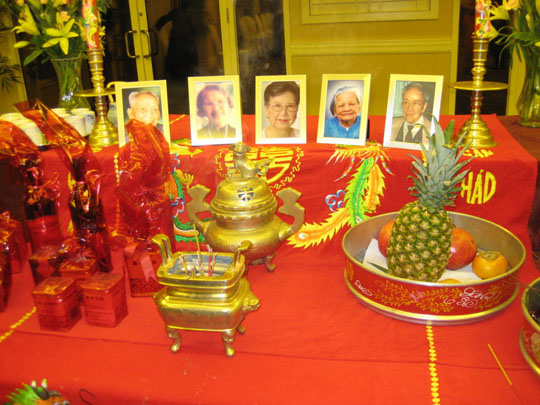 Members of the wedding party brought fruits and other festive things to this ancestor table. Then, after bride and groom payed respects to their deceased ancestors, they served tea to each set of parents, and then to each other.
Members of the wedding party brought fruits and other festive things to this ancestor table. Then, after bride and groom payed respects to their deceased ancestors, they served tea to each set of parents, and then to each other.
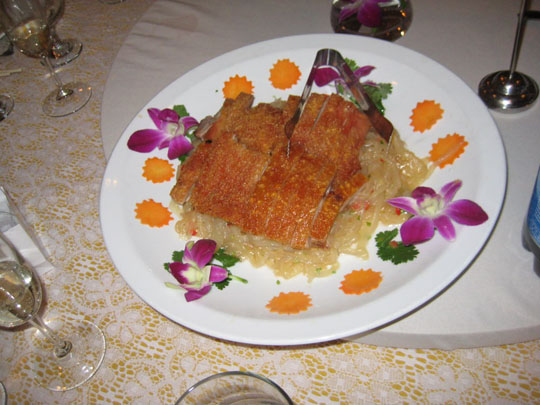 This was in a separate room, and was followed by a wedding banquet in a huge hall that began with a classic cold dish of very crisp roast pig atop a large pile of juicy jellyfish.
This was in a separate room, and was followed by a wedding banquet in a huge hall that began with a classic cold dish of very crisp roast pig atop a large pile of juicy jellyfish. 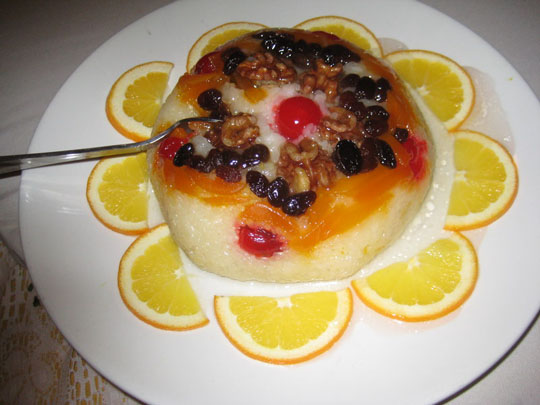 The banquet ended with Eight Precious Pudding. Interspersed were half dozen other delightful and delicious special dishes, each with lobster, conpoy, or another special food.
The banquet ended with Eight Precious Pudding. Interspersed were half dozen other delightful and delicious special dishes, each with lobster, conpoy, or another special food.
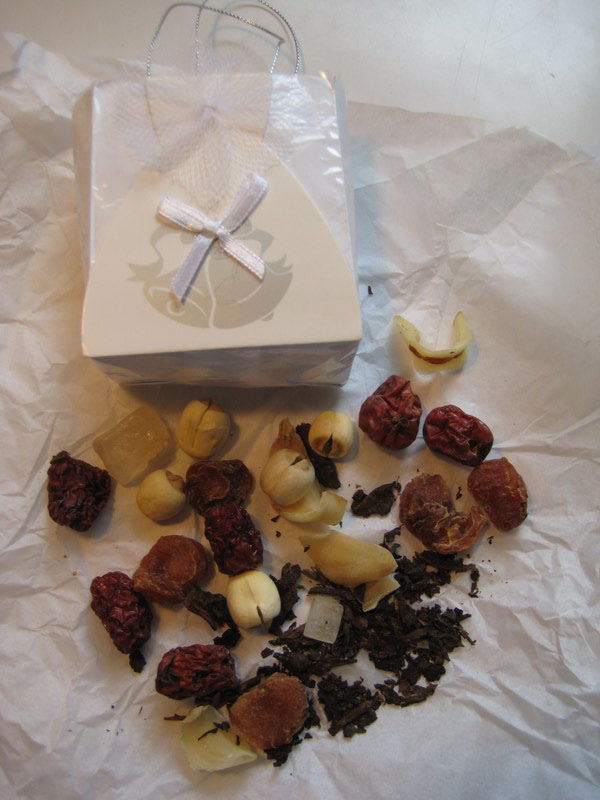 At the end of the event, each guest went home with a small bridal bag of herbal tea; it was filled with pu-er tea, red jujubes, lotus seeds, dried lily-bulb petals, pieces of rock sugar, and more. This mixture is said to bring calm and contemplation and wishes for prosperity, long life, and many progeny to the new couple. What more could they and their parents want for their offspring.
At the end of the event, each guest went home with a small bridal bag of herbal tea; it was filled with pu-er tea, red jujubes, lotus seeds, dried lily-bulb petals, pieces of rock sugar, and more. This mixture is said to bring calm and contemplation and wishes for prosperity, long life, and many progeny to the new couple. What more could they and their parents want for their offspring.
| Wife Cakes are Lao Po Bing |
|---|
9 Tablespoons granulated sugar 3 cups glutinous rice flour or another low protein flour, divided in three equal parts 25 Tablespoons peanut oil or butter, divided into three parts, of ten, ten, and five tablespoons 1 cup high protein flour 1 egg yolk, beaten Preparation: 1. Mix sugar with one cup water and one set of ten tablespoons of peanut (or vegetable) oil. Bring to the boil, and add one cup of glutinous rice flour, stirring to make a ball of dough. Refrigerate for half an hour, remove and knead for ten minutes, then refrigerate this filling material another half an hour. 2. Mix a second cup of glutinous rice flour, a cup of high protein flour and ten tablespoons peanut oil and form a ball of dough and wrap in plastic wrap and set aside for half an hour. This will be used to form the outer layer of dough. 3. Make an inner ball of dough mixing another cup of rice flour with five tablespoons of oil and knead only until it forms a ball of dough that is not sticky. 4. Divide each mixture or ball of dough into eight parts and roll out both the outer and inner dough separately. Put one outer dough on a board, cover it with a rolled piece of inner dough, and roll them together, then in its center, put a section of the filling, and pinch the edges together and press into a round cake. 5. Brush the top of each cake with egg yolk, cut two slits partway into the top layers, and them put on a cookie sheet with sides (in case some filling leaks out). Put the cookie sheet into a 375 degree oven and bake them for twenty minutes. Remove and the wife cakes, and serve them warm or at room temperature. |
| Eight Precious Pudding |
|---|
1 and 1/3 cups glutinous rice 1/2 cup sugar 1 Tablespoon lard 6 pieces extra frirm san cha, a firm fruit gelatin 12 preserved dates 16 candies lotus seeds 1/2 pound walnuts, nlanched 36 raisons 12 dried watermelon seeds, the shells removed 12 dired 'dragon eye' nuts 1/2 cup additional sugar, optional 2 Tablespoons cornstarch, optional Preparation 1. Soak the glutinous rice overnight. Drain in the morning, rinse, ten cook it in six cups of water until soft (aboput two hours), then mix with half cup of sugar. 2. Depcoratively slice the san cha or simply cut it into diamond shapes. 3. Rub a bowl with half of the lard, then arrange the san cha in a decorative pattern. 4. Add the cooked rice being careful npt to disturb the patterned items. 5. Steam over boiling water for forty minutes, then remove and let rest for tenmore minutes. 6. Bub the rest of the lard only in the center of a round platter. 7. Put the platter over the steamed rice, and invert it quickly, then tirn the platter right side up. Note: This can be served hot, warm, or at room temperature; plain r with a sauce made with the optional half cup of sugar and cornstarch mixed with three-quarters of a cup of cold water, brought to the boil, and poured over the pudding. |

Copyright © 1994-2025 by ISACC, all rights reserved
Address
3 Jefferson Ferry Drive
S. Setauket NY 11720